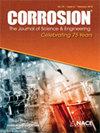在低共晶溶剂中电沉积的 Ag-Ni-Co 合金的微观结构和腐蚀特性研究
IF 1.3
4区 材料科学
Q4 MATERIALS SCIENCE, MULTIDISCIPLINARY
引用次数: 0
摘要
利用脉冲电源技术在低共晶溶剂体系中制备 Ag-Ni-Co 合金涂层。红外光谱和循环伏安法证实金属盐的加入不会改变低共晶溶剂体系。当电流密度为 1A/dm2、电镀时间为 40min 时,镀层晶粒以球形为主,镀层均匀致密。经测试,镀层表面比电阻仅为 1.295mΩ-cm2,显微硬度达到 214.8HV,磨损率达到 3.1。采用宏观电化学和微区电化学相结合的方法分析了镀层和基体的耐腐蚀性能,结果表明镀层的腐蚀电位达到-0.141V,腐蚀电流密度达到 1.299×10-7 A/cm2。镀层的耐腐蚀性远高于基体。本文章由计算机程序翻译,如有差异,请以英文原文为准。
Study on microstructure and corrosion properties of Ag-Ni-Co alloy electrodeposited in low eutectic solvent
The Ag-Ni-Co alloy coating is prepared in the low eutectic solvent system by pulsed power supply technology. Infrared spectroscopy and cyclic voltammetry are used to confirm that the addition of metal salts do not change the low eutectic solvent system. When the current density is 1A/dm2 and the plating time is 40min, the plating grain is mainly spherical; the coating is uniform and dense. After testing, the surface specific resistance of the plating is only 1.295mΩ·cm2, the microhardness reaches 214.8HV, and the wear rate reaches 3.1. The corrosion resistance of the plating and the substrate is analyzed by a combination of macroscopic electrochemistry and micro-area electrochemistry, and the results show that the corrosion potential of the plating reaches -0.141V, and the corrosion current density reaches 1.299×10-7 A/cm2. The corrosion resistance of the plating is much greater than that of the substrate.
求助全文
通过发布文献求助,成功后即可免费获取论文全文。
去求助
来源期刊

Corrosion
MATERIALS SCIENCE, MULTIDISCIPLINARY-METALLURGY & METALLURGICAL ENGINEERING
CiteScore
2.80
自引率
12.50%
发文量
97
审稿时长
3 months
期刊介绍:
CORROSION is the premier research journal featuring peer-reviewed technical articles from the world’s top researchers and provides a permanent record of progress in the science and technology of corrosion prevention and control. The scope of the journal includes the latest developments in areas of corrosion metallurgy, mechanisms, predictors, cracking (sulfide stress, stress corrosion, hydrogen-induced), passivation, and CO2 corrosion.
70+ years and over 7,100 peer-reviewed articles with advances in corrosion science and engineering have been published in CORROSION. The journal publishes seven article types – original articles, invited critical reviews, technical notes, corrosion communications fast-tracked for rapid publication, special research topic issues, research letters of yearly annual conference student poster sessions, and scientific investigations of field corrosion processes. CORROSION, the Journal of Science and Engineering, serves as an important communication platform for academics, researchers, technical libraries, and universities.
Articles considered for CORROSION should have significant permanent value and should accomplish at least one of the following objectives:
• Contribute awareness of corrosion phenomena,
• Advance understanding of fundamental process, and/or
• Further the knowledge of techniques and practices used to reduce corrosion.
 求助内容:
求助内容: 应助结果提醒方式:
应助结果提醒方式:


